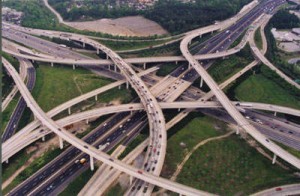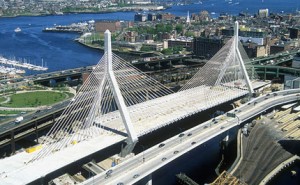America’s critical infrastructure is very important to ensuring both competitiveness and security. The movement of goods, people, energy, and information is vital to a strong economy and defense. In order for such transit to take place efficiently, effectively, and safely strong infrastructure systems and networks must be in place and maintained. Unfortunately, crumbling infrastructure throughout the United States has not only reduced American productivity but left the nation vulnerable to being overwhelmed via homeland disasters. Well-planned and efficient investment in updating and maintaining critical infrastructure is desperately needed to enhance American competitiveness and national security.
An American Society of Civil Engineers (ASCE) report claims that businesses could face up to $1.2 Trillion in extra costs due to deteriorating infrastructure systems. Furthermore, the report card issued by the ASCE assigned America’s infrastructure a D+ grade, citing major deficiencies in the following areas: energy, transit, roads, and levees. Even in the face of rapid online commercialism, traditional structures including roads, bridges, harbors, and railways still remain essential to the transport of raw materials, finished products, and services. Crumbling and inefficient infrastructure will cause higher transport costs for businesses as travel contains more congestion, is not as safe, and does not work smoothly. Such circumstances will act as significant drags on the U.S. economy and thus greatly hamper American competitiveness.
In addition to competitiveness concerns, the deterioration of American infrastructure also presents a host of national security challenges. In a broad, simple view, the quality and efficiency of infrastructure is crucial for the transport of troops, supplies, and equipment for deployment and transit between homeland bases. Response to threats, attacks, and natural disasters require the ability to quickly mobilize and maneuver forces throughout the nation. Poorly designed and inadequate infrastructure will hinder the ability for the United States to respond quickly. Also in the event of a natural disaster, it may further exacerbate the damage ensued as weak levees may break. The nation’s worst fears in this regard were witnessed beyond magnitude during Hurricane Katrina, and yet not much progress has been made.
Major investment in infrastructure repairs and upgrades are desperately necessary for both economic related competitiveness concerns and national security challenges. The aforementioned ASCE report estimates that the United States would need to invest approximately $3.6 Trillion to raise the nation’s infrastructure to an acceptable “B” level by 2020. These costs will continue to rise exponentially should the U.S. choose to sit idly by as more critical infrastructure crumbles and falls by the wayside.
Admittedly, achieving multi-trillion dollars of investment within the next seven years is highly unlikely in the current era of fiscal austerity. However, increased investment in infrastructure must be made through a series of reforms and well-designed programs. Ultimately should the public and private leaders of our nation fail to act, there will be extreme long –run economic, competitiveness, and security consequences.
A strong starting point in this process involves reform of government spending with regards to infrastructure programs such as the Highway Trust Fund. No longer can the federal government allow pork-barrel spending and short-term stimulus objectives to eat away at appropriated budgets. Federally funded infrastructure projects must be carefully evaluated to ensure the most needed and efficient projects are funded rather than those that are used to appease constituents or special-interests. Along with these judgments, a project’s expected economic returns should also be included in the respective cost-benefit calculus.
 In order to overcome the rational (we need to avoid unsustainable deficits for other competitiveness concerns) lack of available government funding, public-private partnerships must be forged. Congress should work to create a “National Infrastructure Bank.” This long-term, fundamental mechanism will help to raise the rate of investment for infrastructure projects as private institutions will see viable returns to their excess, mostly flexible capital. Businesses should also become more aware of the economic benefits such projects will provide their transportation mechanisms.
In order to overcome the rational (we need to avoid unsustainable deficits for other competitiveness concerns) lack of available government funding, public-private partnerships must be forged. Congress should work to create a “National Infrastructure Bank.” This long-term, fundamental mechanism will help to raise the rate of investment for infrastructure projects as private institutions will see viable returns to their excess, mostly flexible capital. Businesses should also become more aware of the economic benefits such projects will provide their transportation mechanisms.
Similar to American Competitiveness writ large, the United States infrastructure is crumbling—and crumbling fast. Long-term solutions are desperately necessary to save the nation from a large magnitude of economic and security problems. Disciplined spending and greater investment fueled by a public-private partnership are requisite to turn things around. Urgency is paramount as the greatest consequences could be just around the corner.


